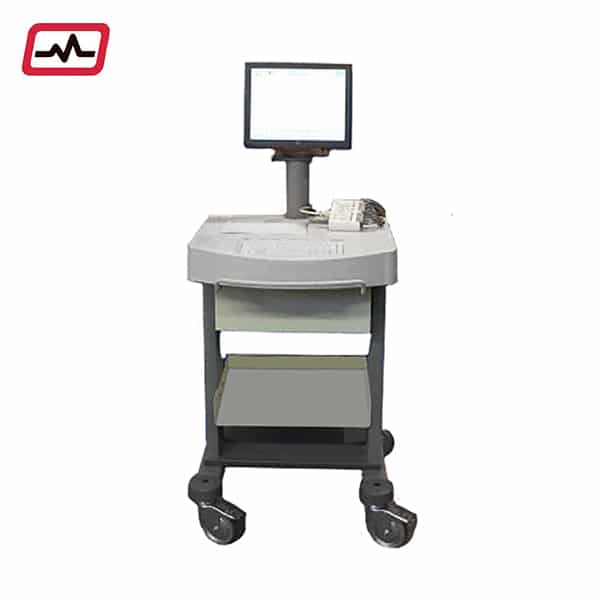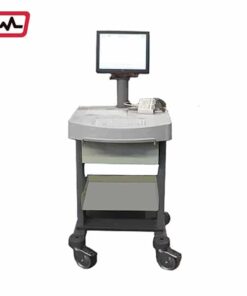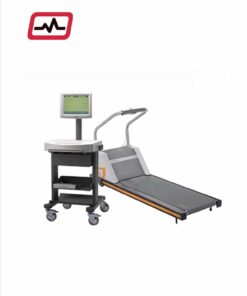Burdick Quest Stress Test System
Burdick Quest Stress Test Console
Refurbished
Patient Ready
Warranty Included

The Quest system is right for offices looking for value, simplicity, and increased patient throughput. The system is easy to use because it features a touch screen with convenient pull-down menus for an intuitive workflow. Burdick’s proprietary Logistep guide walks users through the test by highlighting the next step. We put everything you need on one screen, so there’s no need for toggling among screens. And to save you time, we added an easy way to correct unintentional phase changes without having to start all over again.
- Easy, intuitive touch screen lets you focus on the patient
- Performs both resting 12-lead ECGs and stress tests on one system
- Accurate ECG data acquired at the patient eliminating non-cardiac electrical noise
- Flexible programming means you choose the protocol
- Generous storage, enhanced online data editing and several data management options
- Full-range reporting offers over 15 different report configurations
- Digitally controlled treadmill maximizes system reliability
- Burdick Quest Stress Test System Specifications
Dimensions
60” x 25” x 34” (152 cm x 63 cm x 86 cm)
Weight
<170 lbs. (78 kg)
Monitor
Type:15” High-resolution color with integrated touchscreen
Mount: User-adjustable tilt (•15°) and swivel (•90°)
Content: 3, 4 or 6 ECG channels, real-time; information and alphanumeric data
Displayed leads: User-selectable during a test; (3-, 4- and 6-channel)
Waveform display: •8 seconds per lead of ECG in 3-channel mode
Keyboard
Main keyboard: QWERTY layout
Ergometer control: Dedicated keys for ergometer speed, grade, start and stop
X-ray Power Control
Auto and Manual Mode
Input / output
Digital I/O: RS-232 interfaces to treadmill, bicycle ergometer, and optional automatic blood pressure monitor
TTL pulse for QRS detection, 50 msec. delay
Analog output: 4 user-selectable outputs
Power Requirements
115/230V AC +/- 10%, 2.5/1.25 A, 50/60 Hz nominal 300 VA max
Chart Recorder
Paper type: Pre-grided thermal paper, Z-fold, 8.5” x 11” (US letter) or 210 mm x 300 mm (A4)
Printout device: 216 mm thermal dot array
Paper speed: 10, 25, 50 mm/sec. +/- 2%
Printing options: Multiple format ECG waveform and alphanumeric printing, diagnostic quality; Gain: 5, 10, 20 mm/mV +/- 5%
Frequency response: 0.05 Hz to 150 Hz +/- 10%
Muscle artifact filter: Userselectable: Off, 20 Hz or 40 Hz; Baseline filter User-selectable: Off, 0.12 Hz or STABLE (meets or exceeds all 1990 AHA recommendations)
Calibration signal: 1.0 mV for 200 msec. +/- 5%
ECG Computations
Heart rate computation: 8-beat average, 30 bpm to 250 bpm, updated every second
ST measurements: 20 sec. moving window with 10 sec. updates to the display and to reports
ST parameters: Level, slope for 12 leads simultaneously
QRS detection channels: II, V2 and V5 with switching; Ectopic detection: Ventricular arrythmias, unclassified
ST reference points: User-selectable: E-point (QRS onset), J-Junction (QRS offset), ST point (0 msec. to 100 msec., 5 msec. interval) with display/printout annotation
Protocols
Preprogrammed: Manual, Bruce, Modified Bruce, Balke, Naughton, Ellestad, Kattus, Ramp, Astrand, Modified Astrand, Pharmacological
User-defined: 20 protocols with up to 30 stages each plus
Warmup and Recovery phases
Patient Module
Dimensions: 1.3″ x 4.3″ x 3.8″ (3.3 cm x 10.92 cm x 9.65 cm)
Weight: <1 lb. (0.5 kg)
Frequency response: 0.05 Hz to 150 Hz, +10% to -30% (maximum)
Defibrillation protection: To 360 J, 5 kV
Common mode rejection: >120 dB at 60 Hz
Electrode offset tolerance: +/- 300 mV
Line frequency filters: User-selectable 50 Hz, 60 Hz or off
Noise: <30 µVpp
Pacemaker pulse indication: Per EC13
Input channels: Simultaneous acquisition of 8 leads plus 4 derived leads
Defibrillation recovery: Maximum recovery time is 8 seconds
Patient connection: 10 replaceable leads




